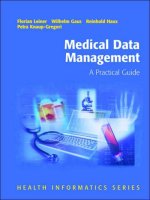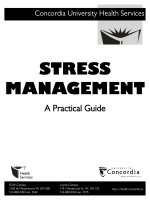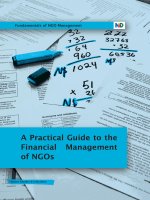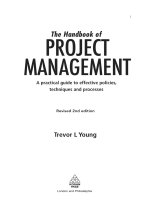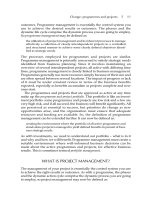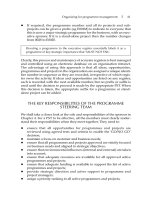Số tay tổ chức sự kiện events management a practical guide
Bạn đang xem bản rút gọn của tài liệu. Xem và tải ngay bản đầy đủ của tài liệu tại đây (6.28 MB, 243 trang )
Events Management a practical guide
5th Floor, Ocean Point One
94 Ocean Drive
Edinburgh EH6 6JH
Email:
Tel: +44 (0)131 472 2313
www.eventscotland.org
Events
Management
a practical guide
A reference for event planning
and production in Scotland
ISBN 10
0-9554126-0-9
ISBN 13
978-0-9554126-0-8
Title Information
Events Management: a practical guide
Copyright © EventScotland 2006
Published in September 2006 by EventScotland
This publication is also available to download
from www.eventscotland.org
Acknowledgements: with thanks to
EventScotland colleagues for their input
Design: Hillside Agency, www.hillsideagency.com
Photography: see appendix, page 226
EventScotland
Ocean Point One
5th Floor
94 Ocean Drive
Edinburgh EH6 6JH
Tel: +44 (0)131 472 2313
Email:
www.eventscotland.org
6
welcome to
events management:
a practical guide
i
This guide has been published by EventScotland to provide a resource of general
advice and support material for event managers. Primarily, it has been designed as a
support tool for our Regional Events Programme, but it may also be of use or interest
to the wider events sector. The aim is to assist effective event management through
the provision of a step-by-step guide to the planning process, together with sample
checklists and adaptable templates.
EventScotland supports a wide range of cultural and sporting events across the country
and whilst the delivery mechanism for each event is different, there are broad key
areas common to the management of the majority of events. The task of providing
general advice and guidance to address this diverse sector was certainly a challenge.
Our two co-authors have extensive professional events management and marketing
experience. The content of this publication is based on their personal experiences,
best practice learned ‘in the field’ and as a response to working with Regional Events
Programme applicants. It does not attempt to provide sector specific advice, nor does
it present itself as the last word in events management.
We hope you find it useful.
David Williams
Chief Executive, EventScotland
event management: a practical guide introduction
Foreword
About the Authors
ii
Co-authors Marie Christie and Lesley McAteer have many years of experience in the
Scottish Events Industry. They have worked together in the creation and delivery of
a wide range of successful events and festivals. Meeting in 1997 whilst at UZ Events,
one of Scotland’s leading events companies, their portfolio includes the Glasgow Art
Fair (00–04), Big in Falkirk, Scotland’s National Street Arts Festival (00–03), Glasgow’s
Hogmanay (96–99), BBC Music Live (99), On the Streets: City of Design 1999,
the Grand Opening of the Forth & Clyde Canal (01) and Glasgow on Ice (00).
Marie Christie
is currently EventScotland’s Regional Events Programme Manager. Since the creation
of the role in early 2004, Marie has worked with events and festivals all over the
country to help them achieve their development potential. With around 50 events
supported each year, Marie has co-written this guide as a tool to support the delivery
of the Programme. Prior to joining EventScotland Marie was General Manager and
Producer at UZ Events. Supplementing her wide ranging events management expertise,
Marie also has a background in arts marketing and has promoted theatre productions
all over Scotland.
Lesley McAteer
is an events producer with extensive experience of creating and managing large-scale
outdoor events, many of which are driven by tourism and economic development
objectives. Having started her career in the entertainment industry in 1992, Lesley
undertook various roles in the areas of music promotions, business management,
college lecturing (business and media), event programming and event management.
Her appointment as Producer of Glasgow’s Hogmanay 1997 marked a new direction in
producing large-scale events. Lesley has co-written this guide as a means of passing on
her knowledge to assist the many exciting and inspiring events and festivals taking
place in Scotland. Recently, Lesley became a partner in McAteer Photograph – an
established and successful locations and events photography company.
This guide has been produced to assist with the effective management of events across
Scotland. Primarily it has been designed as a support tool for EventScotland’s Regional
Events Programme. Taking on board the experience of running the Programme, the aim
was to provide reference material, templates, checklists and ‘best practice’ advice on a
range of key topics common to the delivery of a wide range of cultural and sporting
events. The contents are not fully comprehensive nor are they sector specific and it is
expected that the reader will adapt the advice and customise the guides and templates
to their particular situation.
Who the guide is aimed at
Although this guide has been designed as a support tool for the Regional Events
Programme, it is hoped that its contents will be of use to the wider events sector,
in particular event managers who are:
> New or experienced
> Running medium to large scale cultural or sporting events
> Keen to develop their events further
How to use this guide
This publication is extensive. To help with its navigation each chapter is colour coded
and a summary of each chapter’s content is given in the ‘Quick Find’ guide on page vi.
This guide should be read in conjunction with any locally-focused event management
guides/toolkits offered by your local authority and/or any appropriate sector specific
publications.
Distribution
Applicants to the Regional Events Programme are eligible to receive a free copy of
this guide (whilst stocks last). This publication is also available to download from
www.eventscotland.org
event management: a practical guide introduction
Why this guide has been produced
iii
Introduction
v
Chapter 1
Chapter 2
Chapter 3
Chapter 4
Chapter 5
Chapter 6
Chapter 7
Chapter 8
Chapter 9
Chapter 10
Chapter 11
Chapter 12
Chapter 13
Where to Start – General Planning
Business Planning
Putting the Team Together
Budgets and Financial Management
Making it Add Up – Fundraising
The Programme
Legal Issues
Insurance
Event Production: Operations,
Facilities, Health & Safety
Operational Communications
Marketing and Communications
Visitor Research
Post Event
1
21
31
41
57
81
89
103
111
149
159
199
209
Appendix
Useful contacts and resources
215
event management: a practical guide introduction
Contents
Quick Find
vi
To help you navigate through this guide,
an overview of each chapter’s content is
provided below. Use the colour coded tabs
to locate the chapter you require. Where
templates are provided, the following
symbol (T) is shown.
Chapter 1 Where to Start – General Planning (T)
Page 1
Contains guidance on: 1) the event concept; 2) defining and communicating the event’s vision and mission; 3) setting
SMART objectives; 4) the SWOT analysis; 5) deciding on event dates and venues; and 6) the ‘Event Action Plan’.
Chapter 2 Business Planning (T)
Page 21
Contains an overview on the purpose and usefulness of business planning together with a template/guide to help
event managers formulate their own business plans.
Chapter 3 Putting the Team Together
Page 31
Includes an overview of the types of organisations that run events; an outline of key roles and responsibilities
to consider; recruitment issues, legal obligations and some comments regarding the ’wider team’.
Chapter 4 Budgets and Financial Management (T)
Page 41
Includes guidance/templates to assist with: preparing event budgets, control mechanisms, petty cash, cash flow
projections, tips for managing finances ‘on site’; other financial issues (annual accounts, VAT, gift aid, record of
assets); future planning.
Chapter 5 Making It Add Up – Fundraising (T)
Page 57
Includes: advice on potential income sources (e.g. ticket sales, participant entry fees, public funds, commercial
sponsorship, trusts and foundations, concessions & franchises, merchandising, showcase & demonstration,
advertising, in-kind support, etc); revenue plan template/guidance; advice on raising commercial sponsorship
including a sponsorship proposal guide/template; tips to help you manage the relationship with your sponsor;
a step-by-step guide to the tendering process.
vii
Page 81
Includes general points to consider when structuring your event programme.
Chapter 7 Legal Issues
Page 89
Includes advice and information regarding the organisational structure and legal status of events/event
organisations, event ownership, contracts, licences and permissions, disability issues, equal opportunities,
data protection and insurance.
Chapter 8 Insurance
Page 103
Includes general advice on how to approach event insurance, a checklist of the sort of information an insurer
is likely to require, an outline of the sort of cover events are likely to require, advice on claims management.
Chapter 9 Event Production: Operations, Equipment, Facilities, Health & Safety (T)
Page 111
Includes advice designed to assist with the safe delivery of events: equipment and facilities checklists; an 11 point
guide to assist with site/venue layout; advice on creating site/venue plans; the role of the safety officer, the H&S
policy, the event safety memo, reporting procedures, normal operating procedures, monitoring and inspections, plans
and drawings, method statements, communications, emergency services, medical provision, welfare services, traffic
and transport management, security and stewarding, risk management & assessment.
Chapter 10 Operational Communications
Page 148
This chapter describes two operational communication tools: 1) the event manual and 2) the staff briefing
document. Guides are provided to help you create your own versions.
Chapter 11 Marketing and Communications (T)
Page 159
This chapter aims to give those who are new to event marketing and communications (or those simply in need of some
inspiration) a basic guide to help them through the planning process. Includes: 1) where to start, 2) who should
devise the marketing plan, 3) resources, 4) identifying your target market, 5) forming the marketing objectives,
6) developing the marketing strategy, 7) marketing tools, 8) media relations, 9) a marketing plan template.
Chapter 12 Visitor Research (T)
Page 199
This chapter outlines the importance of understanding the event audience. A basic checklist and questionnaire
template is given as a starting point for event organisers to design/commission their own research.
Chapter 13 Post-Event
Page 209
This chapter includes an overview of the post-event steps that should be taken.
Appendix Useful Contacts and Resources
Page 215
event management: a practical guide introduction
Chapter 6 The Programme
1
chapter one
where to start –
general planning
Good planning is a continuous process and good plans should be adaptable and flexible
– they require a solid foundation and a straightforward structure. This first section is a
step-by-step guide, designed to help you get started in the initial stages of event
planning.
Areas covered in this section include: 1) the event concept; 2) defining and
communicating the event’s vision and mission; 3) setting objectives; 4) the SWOT
analysis; 5) deciding on event dates and venues and; 6) the ‘Event Action Plan’.
We’ve suggested a range of exercises that you might undertake – the point is to get
your plans on paper, look at the timeline available, the resources required and what
needs to be achieved in order to deliver your event.
1) The Event Concept
Successful events are usually based on a strong concept and purpose. Ideas for
holding events arise from a multitude of reasons. For example your idea may have
come from a need or desire to:
> Celebrate a unique aspect associated with your town or area
> Showcase or develop a particular cultural or sporting activity
> Mark an historic occasion, national day or local holiday
> Host or create a competitive or mass participation sporting event
> Encourage more visitors to come and spend time (and money) in the town/area
> Improve or refocus the image of your town/area
> Encourage and celebrate community activity
> Mark an opening or launch
> Etc
3
chapter one where to start – general planning
The planning process is one of the most
important aspects in successful Event
Management: the more robust the plan,
the smoother the journey to success.
4
Whatever the impetus for your event, you will have identified an opportunity and
assessed the various broad risk factors associated with its successful delivery. You will
have considered:
> If the event is unique or if it’s duplicating an existing event
> If there is a gap in the market that the event can fill
> If there is a demand for such an event
> If the resources are available to deliver it
> If the community, the local authority and relevant sector body
will support and ‘buy into’ the event
> If it will be financially viable
> If it will be sustainable in the longer term
> If it has potential for growth
> If there will be any legacy
Always Review and Revise
If the event is staged on an annual or repeated basis, at the beginning of each year’s
planning process always make time to review the reasons that you are staging the
event and to consider how it can be developed further. Don’t make the mistake of
just ploughing on expecting everything to come together in exactly the same way it
did the previous year. Ask yourself:
Why are you staging the event?
> Is the event still relevant?
> Have the vision, mission or objectives changed?
> Does it still have support from the event team, participants, audiences,
community, local authority, funding bodies and sponsors, etc?
How will the event be developed?
> Do you (still) have the right skills in place to develop and deliver the event?
> Can you build on previous successes?
> What areas could be developed further?
> How can interest be maintained?
> Is there potential to attract new audiences?
> How will you maintain or extend the financial viability of the event?
5
> Is the marketing working?
> Do you need to consolidate the event or focus on key elements?
> Has the event reached capacity?
> Has the event reached the end of its life cycle?
With annual or repeated events you should be looking at ways to improve the event
experience and impact year on year.
2) Communicating the Vision and the Mission
If you don’t already have an articulated vision and mission statement for your event,
you may be unsure or confused as to what it actually means to have one. You may
also be a bit sceptical about the need for such statements. Our advice is pretty
straightforward in this respect: by defining the vision and the mission (or purpose) of
the event at this stage, you will be able to more clearly communicate to others what
you hope to achieve, thus providing focus and direction for everyone involved (including
potential funders). In essence, don’t expect others to be able to read your mind.
Your vision statement should be a short statement that describes, in broad terms,
the event’s long term aim. The mission statement sits underneath this and gives
more detail about how the vision will be delivered. These are important positioning
statements and they need to be both concise and achievable. To give you an example,
here’s EventScotland’s vision and mission statement as stated in Scotland’s Major
Events Strategy 2003–2015:
Vision:
To become one of the world’s foremost events destinations by 2015.
Mission:
To deliver a viable portfolio of events to attract visitors to Scotland, to enhance
Scotland’s international profile, to strengthen our sporting and cultural infrastructure
and to maximise the economic, social and environmental benefits of events to all
parts of the country.
chapter one where to start – general planning
> Do you need to widen the scope of the event?
Here’s an example of what a vision and mission statement might look like for a
6
visual arts festival in ‘X-Town’:
Vision:
To put X-Town’s visual arts heritage and community on the Scottish cultural map.
Mission:
Stage an annual visual arts festival with a programme of quality events, exhibitions
and community activities that showcase the work of local artists and engage with the
wider visual arts scene in Scotland, whilst attracting visitors and media interest from
outwith the region for the cultural, social and economic benefit of the artists and
wider community.
3) Setting SMART Objectives
You should also be able to define and communicate your event’s objectives. Your
objectives should help deliver your vision and mission. Objectives need to be clearly
set out and should follow the SMART principle: Specific, Measurable, Achievable,
Relevant and Time-Based:
> Specific: Be specific about what is to be achieved. For instance, if an objective is
to attract tourists to the event, be specific about where they will be coming from,
how many you hope to attract, etc.
> Measurable: A system, method or procedure is required to allow the tracking
and recording of the action upon which the objective is focused. For instance,
a monitoring system should be put in place to record how many tourists came to
the event, where they came from, etc. This could be done through visitor research
and/or ticket data capture for example.
> Achievable: The objectives that are set need to be capable of being reached – never
overstate your objectives. If targets are unrealistic, all you will be doing is setting
yourself up for a fall. For instance, don’t set the target of attracting 1,000 tourists
from North America when you only have a short period of time to market an event
that, realistically, will only achieve 500 day-trippers from neighbouring regions.
for the event is to encourage community activity – do you really need to attract
7
> Relevant: Is the objective important to the event? For instance, if the main driver
tourists as a priority?
As a guide, event objectives often concern themselves with the following types of goals,
but yours should be SMART in accordance with your own particular circumstances:
> Event Growth
> Economic Benefit
> Event Quality
> Tourism Development
> Event Sustainability
> Social Benefit
> Sector Development
> Educational Development
> Audience/Participant Satisfaction
> Community Development
What are your event’s objectives? Are they SMART? What tools and strategies will
you use to achieve them?
4) SWOT Analysis: Strengths, Weaknesses,
Opportunities and Threats
At the beginning of the planning process if you undertake a simple ‘SWOT Analysis’ it
will help determine the Strengths, Weaknesses, Opportunities and Threats (SWOT) in
relation to the event. This will help you shape your plans.
Looking at internal and external influences that may have a positive or negative
impact, consider the strengths and weaknesses of the event and how these will affect
your ability to deliver it. Repeat the same exercise for opportunities that the event
can capitalise on, and the threats that could undermine the event or elements of it.
Consider the following points:
> Event Management – experience within the organisation, staffing numbers and
structure, financial stability, viability of planning, confidence of funders, etc
> Partners/Clients – the support they can/cannot provide: finance, influence,
resources, etc
> Climates – social, economic, cultural and political
chapter one where to start – general planning
> Time-Based: There must be a clearly stated start and completion date for each objective.
> Event Benefits – what the event offers, its ‘Unique Selling Point’ (USP)
8
> Potential to Develop and Grow – factors that will assist or hinder this
> Other Factors – competition, technology, legal, environment
In the initial stages of your planning process it can be useful to list the Strengths,
Weaknesses, Opportunities and Threats relevant to your event in a template similar to
the one below. We’ve given a couple of example entries for our fictional ‘X-Town
Visual Arts Festival’.
SWOT Template Guide
FIGURE 1.1
Strengths
Weaknesses
> Experienced event management team
> Supportive and active network of local artists
> Good local authority support and active
visual arts officer
> Event vision is convergent with local visual arts
and events strategies
> Growing audience base
> Etc…
>
>
>
>
Opportunities
Threats
> Local tourism forum keen to work in closer partnership
> EventScotland’s Regional Events Programme
> Local artist recently awarded major arts prize
bringing increased media interest to the town
> New supermarket opening in town –
sponsorship possibilities attached
> Etc…
>
>
>
>
Lack of marketing and media expertise
Limited sponsorship success
Remote location
Lack of quality accommodation for
overnight visitors
> Poor late night transport
> Etc…
Increasing costs/standstill funding
Event Manager moving on next year
Competition from ‘Y-Town Arts Festival’
Etc…
5) Other Initial Considerations:
Choosing the Date and Venue
Lead Time
Having sufficient time to plan, fundraise, market and implement the event ‘action plan’
is a critical issue. Never underestimate how long the process can actually take. Failure
to allow adequate lead time decreases the chances of success in all aspects of event
10
planning and delivery.
Think carefully about the size and complexity of the event, the resources and funding
that are required, as well as the time needed for effective promotion. Be generous and
realistic in your estimate and consult with all project partners to ensure the time scale
is suitable to them. Remember that factors outwith your control may reduce
organisational time (i.e. public holidays, holidays to be taken by key team members,
illness, etc) so it’s a good idea to build a contingency into every element of your plan.
As a general guide, successful smaller events will require at least six months lead-in
time whilst larger events can take more than a year to plan, and major international
events can take years from the bidding stage to delivery.
For new events, understanding the required lead time should help influence the choice
of event date. When the date is set and agreed by the committee, partners, etc, it may
be difficult to change it. Therefore, if you predict that something may hold up the
planning process – extend the lead time if you possibly can. In some cases you will not
have a choice in terms of when the event is to be held. If this is the case, before going
ahead and committing to hosting the event, ensure that you undertake good initial
planning in order to convince yourself (and others) that it can be delivered successfully.
The Date
The choice of date for your event can have a major impact on its success. Careful
consideration should be given to the range of risk factors involved in selecting the
best date. Consider:
> Nature of the Event – is it an outdoor event; does it need to be staged in a particular
season; is its location intrinsic to its success (i.e. does it have to be in a particular
venue, city/town, location, etc)?
> Weather – what are the probable weather conditions at your preferred time of year;
will inclement weather affect the event; are there contingency opportunities available?
if it is staged at a particular time of year, holiday time, at the weekend, mid-week, etc?
11
> Target Audience – who are you hoping to attract to the event: is this more achievable
diary overly busy? It’s worth talking to your local authority, VisitScotland network
office and other appropriate organisations to check what else is planned for your
area at the time. You should also check to see if your event clashes with any similar
events further afield that may also attract your target audience or participants.
A good place to start are the events diaries on www.visitscotland.com,
www.eventscotland.org, www.sportscotland.org.uk, www.scottisharts.org.uk and
your local authority website. Also think about the potential of your event competing
with other wider issues and stories for media interest.
> Complementary Activity – are there any complementary events or activities taking
place at the same time that could assist your event? Could you work together for
mutual benefits?
> Competition – are there other similar themed or scaled events taking place that are
targeted at the same audience? Is there room for your event in the marketplace at
your chosen time of year?
> Resources – are other major events (football, concerts, conferences, etc) taking place
at the same time that will impact on the resources required to stage your event
(i.e. the availability of accommodation, staff and volunteers, hired equipment and
facilities, venues, support from emergency services, local authority, etc)?
> Other Factors – don’t forget to check out any other influencing or relevant issues
e.g. road or building works planned in the vicinity at the same time as your event.
Shoulder Periods
It is also important to consider the value of placing your event in ‘shoulder periods’
(i.e. times of the year outwith the main tourism season). Placing events at these offpeak times may address issues regarding the lack of resources and conflicting events,
as well as introducing additional economic benefits to communities by attracting new
activity and visitors in an otherwise quiet time. Events taking place in these periods
chapter one where to start – general planning
> Clash Diaries – what else is happening at the chosen location/venue; is the event

